Richard acquired two foreign medals at a recent show he attended and presented them to me. He knows I like to research them and donate them the American Numismatic Society museum in New York. Then last Sunday at an antique show, I also found an unidentified bronze medal.
The best way to identify them is to use a megasearch engine like dogpile. You find a name, a group of words or a date and let the Internet see if they have a reference.
The internet quickly found pictures of the people portrayed on the medals once their identity was determined.
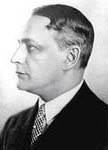


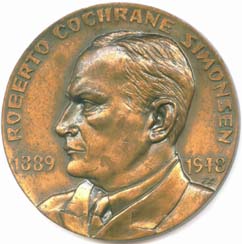
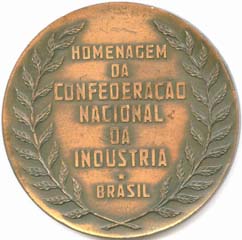
In 1934, he was elected representative for São Paulo and then served in the Senate. Simonsen was imprisoned and passed one season in the exile.
Simonsen, when young was a rich boy and entered the world of the business at an early age. He started in construction and became rich working for the Army. He dealt in copper, rubber and cattle. Simonsen, however, did not do so well in business as in politics. He died with most his companies closed or in control of his family.

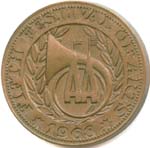
The second medal was in a very nice red box. It is 38mm in diameter with a label inside with the inscription "1968 FIFTH ADELAIDE FESTIVAL OF ARTS". The obverse displays the portrait of Queen Adelaide 1792-1849 with "THE CITY OF ADELAIDE" around. Queen Adelaide Louise Theresa Caroline Amelia, Princesses de Saxe-Cobourg-Meininingen, was the Consort of William IV of England.
The portrait on the medal was taken from the painting of Queen Adelaide, which I found on the internet.
The biennial Adelaide Festival is acknowledged as one of the world's great arts festivals, with a tradition of innovation since 1960.
A search again found a site of a Medals dealer in Australia who had this medal for sale at Au$13.20. His has a green patina, vs. mine original bronze.

The third foreign medal was acquired at a new antique show held at a local church. The dealer said he did not know where he got it or what it was. The medal was bronze, about 1-½ inches in diameter, quite thin. The obverse has a religious figure between two background buildings. The reverse displays a small Virgin Mary with the Greek cross above. The banner inscription below – per asper ad astra is in Latin. The extensive inscriptions - two lines each on both the obverse and the reverse are in Cyrillic. An internet search on the - Latin motto transited it - To the stars through hardship, meaning figuratively "Greatness is only achieved by surmounting problems". This still did not identify the medal. Trying again, as the portrait was of religious figure, I did a search on the word cardinal and the date Dec 22, 1964. Bingo!
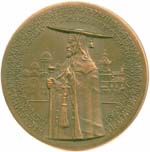

Inscription in Ukrainian – Inscription in Greek
The following summary with a picture of the Ukrainian Patriarch was found.
Patriarch Josyf Slipiy, Major Archbishop, Patriarch, Cardinal and Metropolitan (1944-84). Born in Zazdrist in western Ukraine on 17 February 1892, he was a churchman of three careers: scholar, confessor of the faith and an international voice for persecuted Christians. After studies in Lviv, Innsbruck (Austria), Rome and Paris, he became a professor and then Rector (1928-44) of the Lviv Seminary and Theological Academy. A prolific writer, his collected works include some twenty volumes. In 1939, he was ordained archbishop by Metropolitan Sheptytsky and succeeded him, as head of the Ukrainian Greek Catholic Church upon the latter's death on 1 November 1944.
On April 11 1945 Slipiy was arrested by the Soviet authorities and spent eighteen years in Stalinist prisons, labor camps and Siberian exile, where he earned a reputation for being an iron-willed, intrepid witness to the faith. Through the intervention of Pope John XXIII and President Kennedy, he was released in 1963 to attend the Second Vatican Council.
During the following twenty-one years, Slipiy energized the life of the Ukrainian Greek Catholic Church in the West, establishing the Ukrainian Catholic University and building the Cathedral of St. Sophia in Rome. His death on 7 September 1984 was followed in 1992 by the transfer of his remains to Lviv, where they were interred in St. George's Cathedral with the participation of over a million of the faithful.
This little group was a diverse accumulation of unidentified foreign medals, of little value to the casual eye. Yet when researched, presented a page from the history of worldwide countries during the Twentieth Century. This shows how numismatics and exonumia commemorate people and events in history.
Although I love encyclopedias and have a large numismatic library, without the internet and lots of time, it would be nearly imposable to find the interesting facts above. It only took less than a day to collect, edit with the help of a friend, and write this story. Since posting this story, the three medals have been donated to the American Numismatic Society and may be seen by entering "dewardt" in their search engine as a keyword.
Roger deWardt Lane